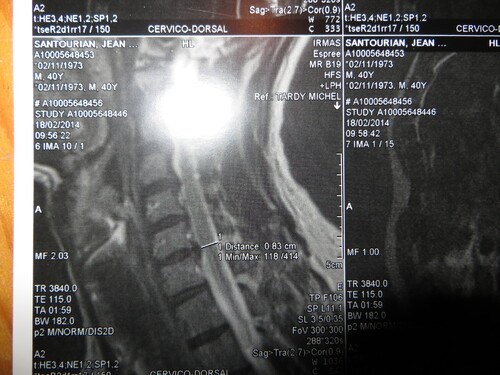-
Un nouvel Espoir......
Nonoperative management of herniated cervical intervertebral disc with radiculopathy.
Abstract
STUDY DESIGN:
A longitudinal cohort study design was used. All patients underwent a systematically and uniformly applied treatment program with increasing intervention as further pain control was needed. All patients were followed up by questionnaire evaluating function and symptoms.
OBJECTIVES:
The role of surgical versus nonsurgical treatment of patients with cervical disc herniation has not been adequately studied. The majority of published data reflects surgical outcomes, with little available data regarding the outcome of nonoperatively treated patients. Frequently, these patients are treated surgically if they have neurologic loss or radiculopathy that persists after rest or minimal intervention. In the authors' clinic,patients with cervical herniated nucleus pulposus and radiculopathy are treated with an aggressive physical rehabilitation program.
SUMMARY OF BACKGROUND DATA:
All patients treated by the authors during a specified time period with a clearly defined diagnosis of cervicalherniated nucleus pulposus were evaluated for outcome.
METHODS:
Twenty-six consecutive patients with cervical herniated nucleus pulposus and radiculopathy were evaluated by an investigator other than the treating physician. The follow-up time was more than 1 year in all patients. Data analyzed included symptom level, activity and function level, medication and ongoing medical care, job status, and satisfaction. Inclusion criteria included a focal cervical disc protrusion of less than 4 mm identified on magnetic resonance imaging and a major complaint of extremity pain compatible with cervical radiculopathy. Exclusion criteria included severe central canal stenosis, symptomatic cervical myelopathy, or condition that precluded participation in the rehabilitation program. Management consisted of traction, specific physical therapeutic exercise, oral anti-inflammatory medication, and patient education. The majority of patientspresented with neurologic loss.
RESULTS:
Twenty-four patients were successfully treated without surgery. Twenty patients achieved a good or excellent outcome of these 19 had disc extrusions. Two patients underwent cervical spine surgery. Twenty-one patients returned to the same job. One patient retired.
CONCLUSION:
Many cervical disc herniations can be successfully managed with aggressive nonsurgical treatment (24 of 26 in the present study). Progressive neurologic loss did not occur in any patient, and most patients were able to continue with their preinjury activities with little limitation. High patient satisfaction with nonoperative care was achieved on outcome analysis.
TRES INTERESSANTE Etude. Le point remarquable est celui de la perte musculaire qui a été le lot de la majorité des patients. La grande majorité a récupéré, ou du moins a pû reprendre une activité quotidienne satisfaisante. Dommage que les patients présentant un canal stenosé n'ont pas été inclus dans l'étude, mais je reste convaincu qu'on doit pouvoir limiter aussi la casse par d'autres moyens que la chirurgie, surtout lorsque celle ci est contre indiquée...... J'ai préparé (et demarré) un programme therapeutique non conventionnel. Je ne manquerai pas de vous tenir informé les whippeux et autres sportifs passionnés qui partagez mes troubles!!
Ze Docwhip
-
Commentaires
l'Art et le Sport des passionnés du Fouet en France





